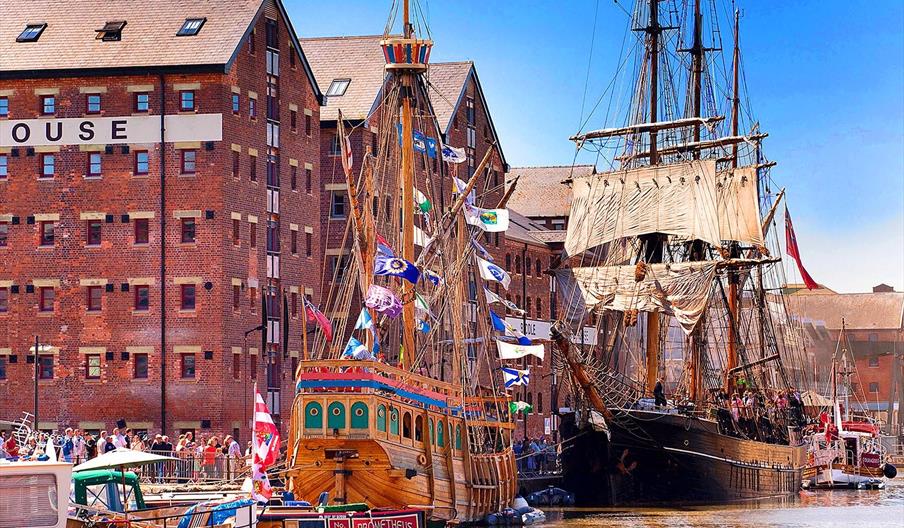
A historic inland port on the Severn, Gloucester is at the doorway to England’s West Country on the cusp of the Cotswolds and therefore the Forest of Dean.
Originally this was the Roman fort of Glevum, defending a crossing on the Severn, and gained its town charter under Henry II in 1155. Gloucester’s cathedral has got to be a priority, for its majestic Perpendicular tower and Norman nave.
In the 19th century, the city’s fortunes were transformed with the development of the Gloucester and Sharpness Canal, and striking Victorian warehouses still surround the city’s docks, which are now an upmarket residential area and mall.
After the war, Gloucester had a blossoming aerospace sector, and you’ll view a rare collection of planes made by the Gloster Aircraft Company at the Jet Age Museum.
Gloucester Docks
Gloucester has England’s most inland port, which happened within the first decades of the 19th century when the Gloucester and Sharpness Canal was completed.
With the arrival of railways and road freight, the docks fell into disuse within the 20th century, before being revived as a trendy residential and commercial area within the 1980s.
There are 15 monolithic Victorian warehouses here, testifying to the number of products that skilled Gloucester when the port was at its peak.
You can also inspect a chapel built for the city’s mariners within the 19th century, a dry dock in working order, and everyone kind of other historic infrastructure, beautifully preserved.
The warehouses have since been becoming museums and housing, while some are adopted by the Gloucester Quays mall.
Buffet Caterers Gloucester Gloucester
Robinswood Hill Country Park
This 200-meter hill to the south of Gloucester once provided the city’s water system.
Springs bubble through Robinswood Hill and were harnessed by Gloucester Abbey within the 1200s.
Reservoirs were dug within the 19th century, and these were filled in during the last half of the 20th century to supply facilities for the country park that occupies Capitol Hill today.
In these 250 acres you’ll absorb stirring views over to the Black Mountains within the west, south to the Severn Bridge and Cotswolds, and north to the Malvern Hills.
A historic orchard has been restored on Capitol Hill, while space may be a nature reserve, offering a habitat for species like badgers, foxes, and red kites.
Gloucester Cathedral
The roots of Gloucester Cathedral return to an abbey found out within the 670s.
The cathedral as we see it had been completed between the 11th and 15th centuries and features a Norman Romanesque core, and embellishments from every phase of English Gothic.
From a distance, you can’t help but be drawn to the 15th-century Perpendicular tower, which is 69 meters high and topped with four intricate pinnacles.
The nave is unmistakably Norman, with powerful circular columns supporting semi-circular bays, under a later Early English Gothic vaulted ceiling.
Look for the late Decorated Gothic East Window, which has Medieval glass, while the cloisters have England’s earliest fan vaults, produced between 1351 and 1377. the foremost important monument within the cathedral is that the tomb for Edward II, who was murdered shortly away at Berkeley Castle in 1327.
Gloucester and Sharpness Canal
Opened in 1827, this 16.5-mile canal cuts across a loop within the Severn between Gloucester within the north and Sharpness within the south.
When it had been completed it had been the broadest and therefore the deepest canal within the world, allowing larger ships to go to Gloucester’s docks than had been possible on this difficult stretch of the river.
The large span of the canal is crossed by bulky swing bridges, beside dainty bridge-keepers’ houses, which lend the canal a particular character.
For a peaceful day within the countryside, you’ll amble along the towpath, stopping on the grassy banks for a picnic or pub lunch.
There’s an outstanding wetland center at Slimbridge beside the canal where you’ll sight wildlife, from migrating waterfowl to otters.
Gloucester Life
This museum for Gloucestershire’s social history is in two stunning half-timbered houses on Westgate Street.
Side by side, these are a 16th-century Tudor merchant’s residence and a townhouse from the 1600s.
According to tradition John Hooper, the Anglican Bishop of Gloucester stayed within the merchant’s house the night before he was burnt at the stake by Queen Mary I in 1555. a number of the items to ascertain inside these houses include equipment associated with fishing on the Severn, period costumes, a reconstruction of a classroom in Victorian times, scenes from domestic life over five centuries, and therefore the interior of a pin factory that wont to get on this site.
